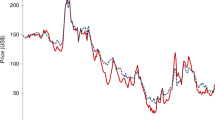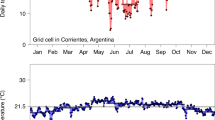Abstract
Macro-economic assessments of climate impacts lack an analysis of the distribution of daily rainfall, which can resolve both complex societal impact channels and anthropogenically forced changes1,2,3,4,5,6. Here, using a global panel of subnational economic output for 1,554 regions worldwide over the past 40 years, we show that economic growth rates are reduced by increases in the number of wet days and in extreme daily rainfall, in addition to responding nonlinearly to the total annual and to the standardized monthly deviations of rainfall. Furthermore, high-income nations and the services and manufacturing sectors are most strongly hindered by both measures of daily rainfall, complementing previous work that emphasized the beneficial effects of additional total annual rainfall in low-income, agriculturally dependent economies4,7. By assessing the distribution of rainfall at multiple timescales and the effects on different sectors, we uncover channels through which climatic conditions can affect the economy. These results suggest that anthropogenic intensification of daily rainfall extremes8,9,10 will have negative global economic consequences that require further assessment by those who wish to evaluate the costs of anthropogenic climate change.
This is a preview of subscription content, access via your institution
Access options
Access Nature and 54 other Nature Portfolio journals
Get Nature+, our best-value online-access subscription
$29.99 / 30 days
cancel any time
Subscribe to this journal
Receive 51 print issues and online access
$199.00 per year
only $3.90 per issue
Buy this article
- Purchase on Springer Link
- Instant access to full article PDF
Prices may be subject to local taxes which are calculated during checkout




Similar content being viewed by others
Data availability
The data on economic production and the ERA-5 climate data are both publicly available at https://doi.org/10.5281/zenodo.4681306 and https://www.ecmwf.int/en/forecasts/datasets/reanalysis-datasets/era5, respectively. Secondary data are available at the public repository for this publication: https://doi.org/10.5281/zenodo.5657457. The maps were created using Matplotlib v. 3.4.2 (https://matplotlib.org/), Cartopy v.0.18.0 (Met Office UK, https://pypi.python.org/pypi/Cartopy/0.18.0), Geopandas v. 0.6.1 (https://geopandas.org/) and GADM administrative boundaries (https://gadm.org/). Source data are provided with this paper.
Code availability
The code to reproduce the analysis is available at the public repository for this publication: https://doi.org/10.5281/zenodo.5657457.
References
Dell, M., Jones, B. F. & Olken, B. A. Temperature shocks and economic growth: evidence from the last half century. Am. Econ. J. Macroecon. 4, 66–95 (2012).
Burke, M., Hsiang, S. & Miguel, E. Global non-linear effect of temperature on economic production. Nature 527, 235–239 (2015).
Kalkuhl, M. & Wenz, L. The impact of climate conditions on economic production. Evidence from a global panel of regions. J. Environ. Econ. Manage. 103, 102360 (2020).
Damania, R., Desbureaux, S. & Zaveri, E. Does rainfall matter for economic growth? Evidence from global sub-national data (1990–2014). J. Environ. Econ. Manage. 102, 102335 (2020).
Holtermann, L. Precipitation anomalies, economic production, and the role of “first-nature” and “second-nature” geographies: a disaggregated analysis in high-income countries. Glob. Environ. Change 65, 102167 (2020).
Kotz, M. et al. Day-to-day temperature variability reduces economic growth. Nat. Clim. Change 11, 319–325 (2021).
Barrios, S., Bertinelli, L. & Strobl, E. Trends in rainfall and economic growth in Africa: a neglected cause of the African growth tragedy. Rev. Econ. Stat. 92, 350–366 (2010).
Min, S. K. et al. Human contribution to more-intense precipitation extremes. Nature 470, 378–381 (2011).
Madakumbura, G. D. et al. Anthropogenic influence on extreme precipitation over global land areas seen in multiple observational datasets. Nat. Commun. 12, 3944 (2021).
Fischer, E. & Knutti, R. Observed heavy precipitation increase confirms theory and early models. Nat. Clim. Change 6, 986–991 (2016).
Marvel, K. & Bonfils, C. External influences on global precipitation. Proc. Natl Acad. Sci. USA 110, 19301–19306 (2013).
Chadwick, R. et al. Large rainfall changes consistently projected over substantial areas of tropical land. Nat. Clim. Change 6, 177–181 (2016).
Lehmann, J., Mempel, F. & Coumou, D. Increased occurrence of record-wet and record-dry months reflect changes in mean rainfall. Geophys. Res. Lett. 45, 13468–13476 (2018).
Zhang, W. et al. Increasing precipitation variability on daily-to-multiyear time scales in a warming world. Sci. Adv. 7, eabf8021 (2021).
Feng, X., Porporato, A. & Rodriguez-Iturbe, I. Changes in rainfall seasonality in the tropics. Nat. Clim. Change 3, 811–815 (2013).
liang, X. Z. et al. Determining climate effects on US total agricultural productivity. Proc. Natl Acad. Sci. USA 114, E2285–E2292 (2017).
Damania, R. The economics of water scarcity and variability. Oxf. Rev. Econ. Policy 36, 24–44 (2020).
Desbureaux, S. & Rodella, A. S. Drought in the city: the economic impact of water scarcity in Latin American metropolitan areas. World Dev. 114, 13–27 (2019).
Hsiang, S. M., Burke, M. & Miguel, E. Quantifying the influence of climate on human conflict. Science https://doi.org/10.1126/science.1235367 (2013).
Davenport, F. V., Burke, M. & Diffenbaugh, N. S. Contribution of historical precipitation change to US flood damages. Proc. Natl Acad. Sci. USA 118, e2017524118 (2021).
Willner, S. N., Otto, S. N. C. & Levermann, A. Global economic response to river floods. Nat. Clim. Change 8, 594–598 (2018).
Beck, H. E. et al. Daily evaluation of 26 precipitation datasets using stage-IV gauge-radar data for the CONUS. Hydrol. Earth Syst. Sci. 23, 207–224 (2019).
Garrick, D. E. et al. Valuing water for sustainable development. Science 358, 1003–1005 (2017).
Ali, S. Climate change and economic growth in a rain-fed economy: How much does rainfall variability cost Ethiopia? SSRN https://doi.org/10.2139/ssrn.2018233 (2012).
Sangkhaphan, S. & Shu, Y. The effect of rainfall on economic growth in Thailand: a blessing for poor provinces. Economies 8, 1–17 (2020).
Loayza, N. V., Olaberría, E., Rigolini, J. & Christiaensen, L. Natural disasters and growth: going beyond the averages. World Dev. 40, 1317–1336 (2012).
Kirchene, H. et al. Long-term impacts of tropical cyclones and fluvial floods on economic growth—empirical evidence on transmission channels at different levels of development. World Dev. 144, 105475 (2021).
Moore, F. C. & Diaz, D. B. Temperature impacts on economic growth warrant stringent mitigation policy. Nat. Clim. Change 5, 127–131 (2015).
Kikstra, J. S. et al. The social cost of carbon dioxide under climate–economy feedbacks and temperature variability. Environ. Res. Lett. 16, 094037 (2021).
Hidalgo, C. A., Klinger, B., Barabási, A.-L. & Hausmann, R. The product space conditions the development of nations. Science 317, 482–487 (2007).
Beck, H. E. et al. MSWEP: 3-hourly 0.25° global gridded precipitation (1979–2015) by merging gauge, satellite, and reanalysis data. Hydrol. Earth Syst. Sci. 21, 589–615 (2017).
Sheffield, J., Goteti, G. & Wood, E. F. Development of a 50-year high-resolution global dataset of meteorological forcings for land surface modeling. J. Clim. 19, 3088–3111 (2006).
Wenz, L., Kalkuhl, M. & Kotz, M. DOSE v.1. The MCC and PIK database of subnational economic output: documentation. Zenodo https://doi.org/10.5281/zenodo.4681306 (2021).
Bador, M., Alexander, L. V., Contractor, S. & Roca, R. Diverse estimates of annual maxima daily precipitation in 22 state-of-the-art quasi-global land observation datasets. Environ. Res. Lett. 51, 035005 (2020).
Myhre, G. et al. Frequency of extreme precipitation increases extensively with event rareness under global warming. Sci. Rep. 9, 16063 (2019).
Klein Goldewijk, K., Beusen, A., van Drecht, G. & de Vos, G. M. The HYDE 3.1 spatially explicit database of human induced land use change over the past 12,000 years. Glob. Ecol. Biogeogr. 20, 73–86 (2011).
Swain, D. L. et al. Increasing precipitation volatility in twenty-first-century California. Nat. Clim. Change 8, 427–433 (2018).
Auffhammer, M., Hsiang, S. M., Schlenker, W. & Sobel, A. Using weather data and climate model output in economic analyses of climate change. Rev. Environ. Econ. Policy 7, 181–198 (2013).
Acknowledgements
We acknowledge funding from the Volkswagen Foundation and from the Horizon 2020 Framework Programme of the European Union (grant agreement number 820712). We thank M. Kalkuhl and S. Lange for discussions regarding economic and climate data, respectively.
Author information
Authors and Affiliations
Contributions
M.K. designed and conducted the analysis and contributed to the interpretation and presentation of the results. L.W. proposed the study, contributed to the design of the analysis and to the interpretation and presentation of the results. A.L. contributed to the interpretation and presentation of the results.
Corresponding author
Ethics declarations
Competing interests
The authors declare no competing interests.
Peer review information
Nature thanks Xin-Zhong Liang, Chad W. Thackeray and the other, anonymous, reviewer(s) for their contribution to the peer review of this work. Peer reviewer reports are available.
Additional information
Publisher’s note Springer Nature remains neutral with regard to jurisdictional claims in published maps and institutional affiliations.
Extended data figures and tables
Extended Data Fig. 1 Historical means of the four principal rainfall measures.
Maps of the historical (1979–2019) means of each annual rainfall measure. a, The annual total rainfall. b, The monthly rainfall deviations (a weighted annual sum of anomalies of monthly rainfall from their climatological means which are, by definition, zero mean). c, The number of wet days. d, The extreme daily rainfall measure (the annual sum of rainfall on days exceeding the 99.9th percentile of the historical distribution).
Extended Data Fig. 2 Historical variability of the four principal rainfall measures.
Historical variability (the standard deviation of annual values over the years 1979–2019) for each measure of rainfall.
Extended Data Fig. 3 Rich and poor differentiated response of economic growth to changes in rainfall.
As Fig. 2 but having estimated economic responses to rainfall for rich and poor countries separately.
Extended Data Fig. 4 Response of sectoral growth to changes in rainfall.
As Fig. 2 but having estimated economic responses to rainfall for the agricultural (“ag”), manufacturing (“man”) and services (“serv”) sectors separately.
Supplementary information
Supplementary Information
This Supplementary Information contains: Supplementary Sections 1–3, Figs. 1–6, Tables 1–17 and additional references.
Rights and permissions
About this article
Cite this article
Kotz, M., Levermann, A. & Wenz, L. The effect of rainfall changes on economic production. Nature 601, 223–227 (2022). https://doi.org/10.1038/s41586-021-04283-8
Received:
Accepted:
Published:
Issue Date:
DOI: https://doi.org/10.1038/s41586-021-04283-8
This article is cited by
-
The economic commitment of climate change
Nature (2024)
-
Global warming and heat extremes to enhance inflationary pressures
Communications Earth & Environment (2024)
-
Climate damage projections beyond annual temperature
Nature Climate Change (2024)
-
Going beyond averages
Nature Climate Change (2024)
-
The overlooked health impacts of extreme rainfall exposure in 30 East Asian cities
Nature Sustainability (2024)
Comments
By submitting a comment you agree to abide by our Terms and Community Guidelines. If you find something abusive or that does not comply with our terms or guidelines please flag it as inappropriate.



